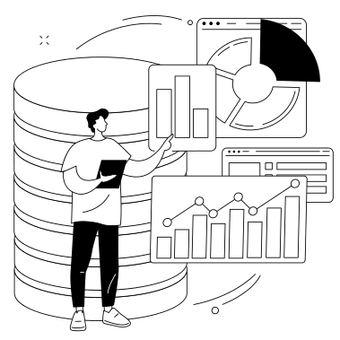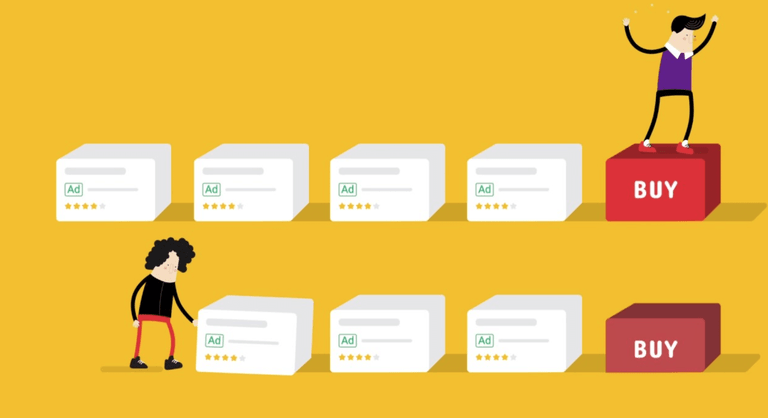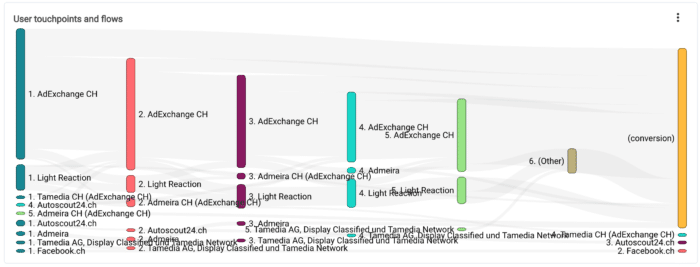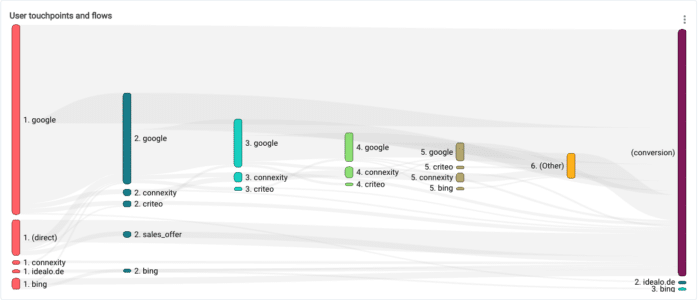Google has rolled out the data-driven attribution to most accounts now. It requires quite a large amount of data to work though.
Using data-driven models simplify optimisations. When the models work they make it easier to analyse campaigns based on the amount of revenue or conversions they have contributed with. This makes it easy to optimise based on one KPI instead of looking at click-troughs, clicks etc.
Data-driven attribution uses machine learning and allocates conversion credits to the different marketing touch-points along the customer journeys. Let’s take a look!
Table of content
- The two different data-driven attribution models
- How does data-driven attribution work?
- Data requirements for Google data-driven attribution
- Data-Driven Attribution in Looker Studio
- Data-driven attribution per keyword or ad content
- Data driven attribution for affiliate ROI, Connexity, Awin, Shopbots
The two different data-driven attribution models
There are two widely used algorithmic attribution models: Shapley value (this is the one Google uses) and Markov model.
The markov model can work on less data and is faster computationally so it’s easier to go down to keyword and content level in the analysis when there are less conversions.
Data-driven attribution takes into account all marketing touchpoints in a customer journey. So it is multi-touch attribution.
Compared to last-touch or last-click attribution it makes it possible to move into early funnel marketing channels to acquire more customers.

Try Windsor.ai today
Access all your data from your favorite sources in one place.
Get started for free with a 30 - day trial.
How does data-driven attribution work?
Here is the example Google provides on how the data-driven attribution works:
You own a tour company in New York City, and you use conversion tracking to track when customers purchase tickets on your website. In particular, you have one conversion action to track purchases of a bike tour in Brooklyn. Customers often click a few of your ads before deciding to purchase a ticket.
Your data-driven attribution model finds that customers who click your “Bike tour New York” ad first, and then later click “Bike tour Brooklyn waterfront,” are more likely to purchase a ticket than users who only click on “Bike tour Brooklyn waterfront.” So the model redistributes credit in favor of the “Bike tour New York” ad and its associated keywords, ad groups, and campaigns.
Now, when you look at your reports, you have more complete information about which ads are most valuable to your business.
More on this here: https://support.google.com/google-ads/answer/6394265?hl=en
In this example the earlier touch-points also get conversion credits with multi-touch attribution, for example the first touch-points with Adexchange and Light Reaction.
Data requirements for Google data-driven attribution
To get started with google data-driven attribution the account needs 600 conversions in a 30 day period and 15 000 clicks. To continue using the model a level of 400 conversions has to be maintained. If this level is not maintained then the model will be switched to linear model.
Windsor.ai attribution can work with less data and we can go to keyword level much easier.
We recommend to switch to multitouch attribution or data-driven attribution because it makes the analysis so much easier. It becomes possible to look at one KPI and make decisions based on that.
Especially with complex customer journeys and programmatic platforms it can sometimes be directly misleading to look at clicks, click-trough rates etc. So it is much better to really look the contribution of the conversions and put that into perspective to the costs to get a data-driven ROAS or a data-driven CPA.
Data-Driven Attribution in Looker Studio
Are you interested in understanding the true performance of your marketing channels? You will need to look beyond last click attribution.
People make passionate arguments about first or last click attribution. When it’s my budget and company on the line, I go with the data and science every time. — Bill Macaitis, former Slack CMO
Visualising non last click attribution models in Looker Studio is impossible. To jump straight into it here are two ways you can get started with non last click attribution.
Your two options
1.Connect your raw Google Analytics data and setup the Looker Studio Multichannel Attribution Dashboard Template. In case you have additional dimensions from other data sources in Looker Studio you can just blend them together with the multi-touch attribution data source. The steps necessary are:
- Copy Dashboard
- For the New Data Source, select CREATE NEW DATA SOURCE
- Under Community Connectors, go to EXPLORE CONNECTORS, find Ad Data + Attribution By Windsor.ai, add the connector
2.Use your existing Google Analytics connection in Looker Studio and follow the 4 steps below:
- Copy the Looker Studio Facebook Ads E-commerce Dashboard Template
- To get the data-driven attribution set up, select CREATE NEW DATA SOURCE in Looker Studio
- Under Community Connectors, go to EXPLORE CONNECTORS, find Ad Data + Attribution By Windsor.ai, add the connector
- Install it and blend the data (see video below)
Related articles:
Examples of a Looker Studio dashboard
Best Free Google Data Studio Templates
Data-driven attribution in digital marketing with AI & ML tools
Data-driven attribution gives the most credit to your best channels and eliminates underperforming ones. However, to apply this model you need an expert data scientist, and other resources to conduct the measurement properly.
Data collection of the marketing actions is a pain for marketers, as in some cases, like with offline marketing, it’s hard to evaluate a customer’s behaviour. While using different touchpoints in marketing, the use of data-driven attribution tools that help to understand when and how various marketing channels contribute to those conversions are very important for defining a marketing strategy.
Thanks to data science, and its tools like AI or machine learning, marketers can predict ROI and ROAS in their 2023 planning more accurately. Marketing managers apply AI and machine learning to unified cross-channel campaign data.
Data-driven attribution per keyword or ad content
Some of our clients like to not only use the high-level budget optimiser but go very granular with their analyses. They sometimes analyse the attributed revenue for every keyword and the customer journeys containing those keywords. This way they get data-driven attribution per keyword and journey.
Here is an example of what it can look like to have a data-driven attributed ROAS per keyword:
When the ROAS is calculated with multi-touch attribution it simplifies the analyses because then the keyword gets credit wherever in the customer journey the keyword has appeared so the analyses become simpler.
Those who want to drill down into the keywords on a customer journey level can of course do so also. Then it can look like this:
Then it becomes possible to search for the keywords so one can find the keywords wherever they appear in the path.
Doing data-driven attribution per keyword and journey usually provides lots of insight and data so most of our customers dont go down to this level but some like to quite granular.
Data driven attribution for affiliate ROI, Connexity, Awin, Shopbots
How do you measure ROI or ROAS for affiliate programs like Connexity, Shopbots and AWIN? Many of our clients use the data driven attribution in Windsor.ai to measure the performance of affiliate and price-comparison marketing channels. The multitouch attribution modelling gives you the conversions or revenue the affiliate programs helped bring.
This is not yet actionable in itself though. The attributed performance figures have to be connected to cost data to be comparable. Only when you know how much was paid for those conversions or revenue it can be compared to the other channels and assessed whether its a good investment or not.
We generally see very good performance of most of the affiliate programs. Especially its working well for many e-commerce clients when compared with the rising CPC prices on Google.
Here are some of the affiliate programs many clients use:
- https://www.awin.com/
- https://connexity.com/
- https://global.rakuten.com/corp/
- https://affiliate-program.amazon.com/
Increasing the volume on the very profitable affiliate channels is sometimes not so straightforward though. Sometimes the only way to do it is via increasing the product catalog instead of increasing the bids and budgets.
We are working with many of the other affiliate programs and price comparison sites to set up automatic data transfer.
If there are some price comparison or affiliate channels you would like to see automatic data import from just let us know. AWIN is probably the one being asked the most currently. Also the price comparison sites in Germany like billiger.de and also comparis.ch in Switzerland are being requested quite a lot.
Amazon Ads especially in e-commerce is growing fast but e-commerce companies are a bit wary about amazon growing so big and powerful.
Connexity tags and tracking advertising ROAS
Many of our clients are using Connexity for advertising and it is generally performing really well. Some of our clients have been quite surprised how well it performs once they see the ROAS. This can easily be achieved in parallel to using the connexity tags.
Typical client situation is that they use Google Analytics for tracking and web-analytics. Some use Looker Studio for reporting and then every individual platform for channel performance.
So for Facebook the Facebook reports, for Bing the Bing reports, and so on.
For Connexity also, but as its a smaller the reporting is maybe not trusted so much as it comes from the advertiser itself. So when they plug in Windsor.ai and see the real multi-touch attributed ROAS it can many times be quite a big surprise how well connexity performs. With Connexity we have automatic cost import so for any advertiser using Connexity they can automatically get the ROAS for Connexity with data driven attribution.
Multiple clients have then increased the spending on Connexity. Benz24 is a good example of this. The case study is here: https://windsor.ai/case-benz24/
Sometimes its not so easy to just increase the spending but instead maybe the whole product catalog on Connexity has to be increased. Alternatively looking for other similar channels.
When all marketing data is in one place and attributed properly it becomes easy to compare the performance and optimise the budgets.
We at Windsor.ai are very happy to work with Connexity as they are a very agile and technical team and also like to push data driven marketing forward. So Windsor.ai data driven attribution together with Connexity tags can provide you superior insights and decrease reliance on the dominating platforms.
WINDSOR.AI’s clients typically improve marketing ROI by up to 30%, free themselves of unprofitable campaigns, and focus their marketing with data-driven customer journey insights. We use trendy AI and data-driven analysis combining with attribution modelling that tells you what works and what doesn’t.
Request a demo or be in touch with us, and read the stories of success from some of our clients.

Try Windsor.ai today
Access all your data from your favorite sources in one place.
Get started for free with a 30 - day trial.





